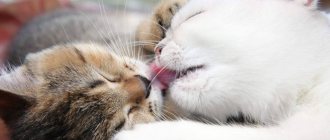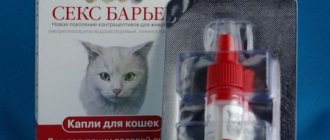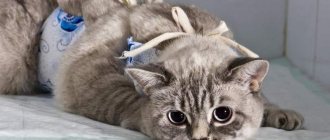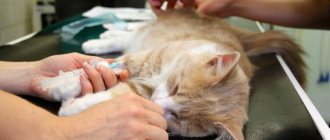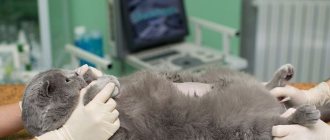When choosing a pet, many people want to get a cat rather than a cat, associating this with the fact that there are fewer problems with a cat during puberty. There is also no need to further accommodate the born kittens. It is not difficult to understand that a cat is asking for a cat, since a male animal shows this very clearly. Not many people know that a cat can show a desire to mate all year round, and not just in the spring. It is worth remembering that once you show readiness to procreate, the cat cannot be re-educated.
About the average age of cat maturation
For the first time, the physiological need for male attention arises at 6-9 months, but in many long-haired and large breeds, such as the Maine Coon, this process drags on for up to a year. And vice versa, short-haired and outbred animals born in the fall can begin to walk by spring; this is inherent in their nature.
Cats can carry, give birth and raise viable offspring without complications only at actual maturity. Therefore, you should not start mating with a cat before 1-1.5 years of age, as this can cause serious health problems.
“Vulnerable” places of Scottish folds
Scottish Fold is classified as an undemanding strong breed. But every artificial species has “vulnerable” places.
What problems do owners of fold-eared cats encounter?
- Diseases of the musculoskeletal system. In adulthood, problems with the development of bone and cartilage tissue begin.
- Cats easily gain excess weight as a result of a sedentary lifestyle and an unbalanced diet. This gives impetus to liver and heart dysfunction, and the risk of serious problems increases.
- The ear is the weakest point of the Scottish Folds. Responsible owners of fold-eared cats regularly inspect their pets' ears and clean them of dirt and wax. Otherwise, an inflammatory process appears and enters the chronic stage.
- Long-haired cats suffer from the appearance of dense mats due to insufficient coat care. This reduces mobility and negatively affects muscle tissue throughout the body.
There are diseases that are most often inherited by Folds.
What diseases do cat owners face:
- Osteochondrodysplasia. Health problems can be identified by lameness and hardening of the tail.
- Osteoarthritis is joint stiffness.
- Hypertrophic cardiomyopathy is a problem with the functioning of the heart.
- Polycystic kidney disease.
Important! If crossed incorrectly, the risk of bone problems increases.
Mr. Cat recommends: how to determine the onset of heat
The onset of puberty is marked by a combination of signs, including:
- changes in behavior from affectionate to aggressive;
- a shrill meow resembling a cry of pain;
- frequent licking of the genitals;
- increasing the frequency of trips to the toilet, marking the territory;
- decreased appetite;
- the desire to find a male in the house or outside it;
- falling on the front paws and lifting the tail;
- rolling on the floor, playfulness.
Before estrus, the cat begins to walk more, becomes gentle and demands affection.
If such symptoms are not detected until a year or later, the cause may be the so-called “erased estrus”, which is the basis for a trip to the veterinarian.
What is happening to Murka at this time?
Experts divide the rut into four main periods. It is difficult to see clear boundaries between them, but knowing how to understand when your pet is having sexual activity will be useful. The owners will better understand the feelings of the pet and will be able to choose the optimal time for mating. This will increase the cat's chances of starting pregnancy at the right time. The defining moment is the exact determination of the first day of the cycle.
Proestrus
The initial stage lasts from a day to four, often lasting two days. The pet eats less, there is slight discharge and swelling of the genitals. The cat becomes affectionate, reacts aggressively to the cat or remains indifferent. The process has just begun, the pet is not ready for mating. It is worth assessing what color the discharge is during the rut. They should be scanty, transparent, odorless.
Estrus
This is the active phase, suitable for mating, and lasts five to ten days. Now it becomes clear what this process looks like in a cat. Now characterized by increased hormonal levels and heavy discharge. The cat's behavior acquires a pronounced desire to mate. She arches, rolls on the floor, wriggles, throws her tail, and makes unusual body movements. The pet does not purr, but rather screams.
The inability to release sexual energy during mating can cause mustachioed beauties extremely unpleasant physical sensations, which is why they scream. Any disciplinary measures will increase stress; neither persuasion nor punishment will change the endocrine background of the pet. If estrus is asymptomatic, behavior remains calm, and there is a high probability of problems in the gynecological area.
Interestrus
It is called post-estrus or metestrus. Depending on whether there was mating, here are the options for the development of events:
- fertilization has occurred, pregnancy has occurred, kittens will appear in ten weeks;
- after mating, fertilization did not occur, a false pregnancy occurred, lasting thirty to forty days, then the next rutting period will begin;
- there was no mating, arousal will gradually decrease over a period of two days to two weeks.
In this phase, the manifestation of aggression towards the male is considered natural. New hormonal changes associated with a return to normal or the development of pregnancy again affect the animal's behavior. The pet begins to calm down and does not let the cat near.
Anestrus
The resting phase from metestrus to the next estrus. In cats that are regularly bred after pregnancy or childbirth, this period may be longer than in a pet that has gone through an empty heat. Aneestrus lasts several weeks or months. Felinologists note that numerous rutting periods that do not end with fertilization do not bring benefit to the cat. The likelihood of developing a number of diseases increases. It is necessary to decide now how to stop or interrupt the next hunt.
Duration of estrus
The length of a cat's cycle is determined individually for each individual. For the first time it can last 5-10 days, and sometimes reach 15-25 days and change as the hormonal balance changes. These indicators differ in animals of different breeds:
- Fold and British cats mature closer to a year, estrus lasts up to a week and occurs 3-4 times a year in Scottish cats, and no more than 2 times in British cats;
- in Persians, ovulation begins at six months of age, lasts 3-7 days and occurs quite often;
- in Bengal and Thai cats, puberty is most often observed from 6-8 months, cyclically once every 1-3 months, for 5-8 days;
- Siamese breeds and sphinxes walk 5-7 days every month, starting from a year;
- bobtails mature at 8-10 months, and in cats with medium hair there are 1-4 annual cycles of 4-6 days, and in short-haired cats - 6-7 of 10 days.
Puberty of cats: castration or hormonal drugs
What happened? The kitten just became an adult.
What is puberty
Animals, like humans, enter puberty, when the body's hormonal levels change and it becomes ready for reproduction. In cats it occurs at 7-8 months and sexual heat begins. By human standards, this is 7-10 years, but unlike humans, animals at this age are already ready to mate. Cats begin to go into heat, repeating every 3-4 weeks, the cat needs a female, and constantly.
Signs of heat
During the period of sexual hunting, the behavior and character of the pet changes greatly. There are many signs that an animal needs mating:
- both male and female cats become aggressive;
- scream (meow invitingly), especially at night;
- cats begin to mark their territory (i.e., leave urine marks throughout the house);
- cats become intrusive, constantly rub against the owner or pieces of furniture, walk on half-bent legs, raising their butts, their tail is constantly raised;
- animals tend to go outside (even those who have never been there);
- become disobedient and may start doing dirty tricks;
- cats often refuse to eat.
If in a cat these symptoms appear and last only during the period of estrus, then in cats the sexual heat lasts a whole year, which means that screams, marks and other “charms” of sexual heat will constantly torment the owners. Moreover, even if you bring a cat together with a cat, this will not discourage him and will not “make him sad.”
Both male and female cats suffer if mating does not occur, so owners need to solve this problem as quickly as possible. And there are three ways to solve it:
- provide animals with complete freedom and access to the street (or constantly bring the animals together);
- spay or neuter your pet;
- Constantly give the animal hormonal drugs that reduce libido.
The first option is not suitable for everyone: complete freedom of the animal is fraught with consequences (lichen, worms, fleas, various diseases that the pet brings from the street), and the kittens will need to be placed somewhere. Therefore, the choice is mainly between castration (sterilization) and drugs.
Pros and cons of castration (sterilization)
A very common and effective way to neutralize the animal's need to mate and reproduce. These procedures are performed surgically. Moreover, castration and sterilization are radically different.
Sterilization is considered more humane and safe than castration. Animals of both sexes can be sterilized, but it is more suitable for cats. The essence of this operation is to ligate the fallopian tubes in cats and the seminal canals in cats, that is, the reproductive organs of the animals are not removed. Sterilization only results in the inability to reproduce, but does not prevent the release of sex hormones, and therefore does not solve behavioral problems.
In addition, sterilization also has a number of negative consequences:
- the risk of breast and testicular cancer increases;
- problems with the urinary system may appear;
- Animals may also experience prostatitis and inflammation of the uterus.
Castration is a radical method; during this operation, the seminal glands are completely removed in cats, and the uterus and ovaries in cats. Although this method seems cruel, it is very effective. Since the organs responsible for the production of sex hormones are removed, all problems associated with the pet’s behavior disappear. He becomes affectionate and calm again. In addition, thanks to the castration procedure, the animal’s lifespan increases, its mental abilities increase, and the risk of diseases of the genitourinary system decreases. But there are several reasons why owners are afraid to subject their pets to this procedure:
- obesity may develop;
- the animal may not tolerate anesthesia;
- there is a risk of kidney stones;
- Heart disease develops with poor diet.
Hormonal drugs to reduce libido
Recently, more and more cat owners are inclined to solve the problems of sexual heat with the help of special medications, which are available in the form of tablets or drops. Indeed, this method allows you to avoid surgical intervention in the pet’s body and the associated consequences (what it takes for the animal to survive anesthesia). A lot of pharmaceutical companies produce such drugs, the choice is great and the price is also different. But it is important to understand that the cheaper the medicine, the more contraindications and side effects it has (cheap cannot be good).
It is also advisable that the drug be selected by a veterinarian, taking into account the age, weight, breed and health status of the cat. After all, this is also a kind of medicine that may, at best, simply not be suitable, or at worst, seriously harm the animal.
The disadvantage of such drugs is the high concentration of hormones, which, if used for a long time, can cause hormonal imbalances and aggressiveness in the cat’s body. And after the first use, the animal will not be in the best shape - the drugs cause general lethargy and detachment. Of course, only the owner can decide which method to choose to reduce the pet’s sex drive. But, the main thing is not to forget that we are responsible for those we have tamed, and are responsible for their safety, health and life.
What to do
For the owner, there are the following ways to solve the problem of estrus in a pet:
- Sterilize to protect against pregnancy forever. In this case, there is a risk of hormonal imbalance and suppuration of the sutures.
- Use contraceptives. They will dull arousal, but there is a danger of harm to health from taking hormonal drugs.
- Connect with a male. After the birth of kittens, the cat will become calmer and will walk less.
- Distract from sensations during heat. Buy new toys, pay more attention.
If the owner is in doubt about what to do with the pet, it is worth contacting a veterinarian for advice. This will help avoid new health problems.
1111
How many days does a cat walk?
One of the main questions that arises for cat owners is how long do they walk? There is no clear answer to this question, since many factors influence the duration of estrus .
The duration of the period depends on:
- Age;
- Time spent without a cat;
- Living conditions;
- Environment, weather, time of year;
- Nutritional features;
- The physical condition of the cat;
- The nature of the pet's body.
In pets, estrus most often lasts from 5 to 10 days. The first estrus may be short-lived . With age, the duration increases, as the pet’s hormonal background forms and changes. In different breeds, a duration of up to 20 days can be observed.
Estrus requires constant monitoring by the breeder. You need to know how long your pet normally goes into heat.
If deviations occur and the heat lasts too long, this may indicate the presence of an ovarian cyst or tumor. A visit to the veterinarian is required to undergo an ultrasound examination.
How to behave as an owner
Mating is a natural step for a current female, but it is not always possible. It's a bad idea to breed a female cat during her first heat. Simple methods and techniques will help ease the baby’s suffering:
- distract with favorite or new toys;
- pick up, stroke, massage, soothe with gentle words;
- feed frequently in smaller portions;
- reduce room lighting;
- use sedatives recommended by your veterinarian;
- invite an active neutered male for mating.
Some owners independently stimulate the cat to help the pet get through a difficult period if the cat does not want the cat or is unavailable. First you need to put a glove on your hand and prepare a clean cotton swab. You need to stroke the cat, which is in a state of rutting, on the back, and gently grab it by the withers.
The vulva is then gently stroked until the vagina begins to pulsate and the tail is pulled to the side. Now you can slowly insert a cotton swab or other suitable object inside. Stimulation is carried out until discharge occurs. The procedure is repeated several times.
If there are cats in the house, and mating is not planned, the current female must be isolated and harmless folk remedies used to calm her down. The bed should be placed next to a radiator or other heat source, and a warm heating pad should be placed. Frequent bathing helps relieve tension. You need to wash your pet carefully. If Murka does not like water, the irritation will not subside, but will intensify. Sometimes catnip or decoctions of soothing herbs: lemon balm, chamomile give results.
There are herbal soothing drops and tablets to stop Murka from screaming:
- Stop Stress;
- Cat Baiyun;
- Anti-stress.
They have a mild effect and do not affect the hormonal state of the animal. There are relatively safe means in the first aid kit to calm Murka down. Suprastin is given at the rate of a quarter of a tablet per five kilograms of weight, once a day towards night, for three days.
Suprastin suppresses the psyche of fluffies; it cannot be considered as a replacement for hormonal therapy or sterilization. The medicine is prescribed as a temporary measure after childbirth to delay the onset of a new pregnancy.
On specialized forums there are reviews, photos, prices for medicines, recommendations on what else can be used for a pet during estrus. If she starts peeing anywhere, marking her territory, she needs to use special underpants.
When does a cat start begging for the first time and how to understand it?
The cat is a mystical creature. People have long believed that these unique animals are capable of not only giving their owner warmth and love, but also protecting them from any negativity. When purchasing a fluffy cat, you need to remember that, as she grows up, she will begin to go for walks. Always affectionate and calm, one fine day she will begin to behave very strangely: meow loudly, calling for the cat. But after some time, the “cat concert” will pass, and the pet’s behavior will again be normal. This article will tell you at what age a cat begins to ask a cat, how to understand it and what to do.
Mating cats
It is important to know how to properly match a cat with a cat so that the whole process is successful.
First you need to find a partner. It is advisable to do this in advance, and it is better to introduce the animals in advance. You can find a suitable cat in a cat club, by visiting an exhibition or by advertising in a newspaper or on the Internet. To prevent mating from causing harm, it should be carried out after reaching a certain age, and both animals should be checked for the presence of fungal, viral, infectious and other diseases. Also, before mating - 2 weeks - experts advise deworming. Before introducing a cat to a cat for the first time, it is recommended to trim its claws. This is necessary so that she does not cause injury during the mating process. You should not bathe the animal before mating. Because this can wash away the natural scent of the bride, which is so attractive to the cat. It is better to pair your pet with a male on the 3-5th day of estrus.
It happens that a cat does not allow the male to approach her. And this is not surprising, because these creatures are very capricious and capricious. If the situation or the male is not to your liking, problems with mating are guaranteed. There are also individuals that never allow males to approach them. Most likely the reason for this behavior lies in an incorrectly formed sexual instinct. But this may also be due to problems with the uterus or ovaries. If your pet likes the cat, it is better not to change it. After all, representatives of the cat family are monogamous. It is recommended that a cat give birth no more than 3 times every 2 years.
